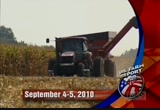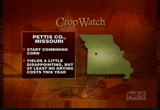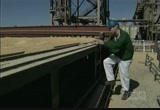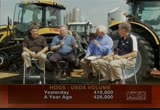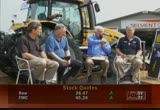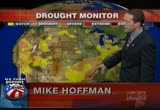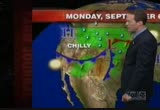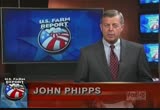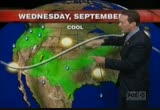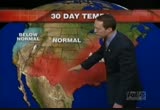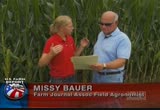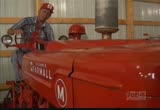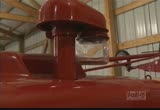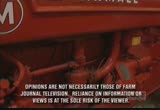tv U.S. Farm Report FOX September 5, 2010 4:00am-5:00am EDT
4:00 am
today on u.s. farm report, early corn harvest begins in the midwest. exports provide a glimmer of hope to the ailing economy. and our market experts look forward at the farm progress show. hello and welcome to u.s. farm report. i'm john phipps. many farmers in my area and go on all summer about how our corn can be ready in august. guess what, the corn beat the calendar.
4:01 am
in fact, the most recent wager is some will try to be done with harvest by the date they started last year. that's not impossible, but it means that 2010 will be one of the fastest harvest, but also the -- >> with al gone this week, i'll give it a try. the nation's corn crop continues to advance. 70% is considered mature. the average is 11 percent. this field is in delphi. john sullivan said he's never shelled corn in august. >> we had some beans one year that i can remember, but usually it's the latter half of september. >> so this is the earliest.
4:02 am
>> by far. >> indiana had a 23 day run of 90-degree days, which really dried down the crop. >> crop watch this week looks at three states dealing with dryness. a grower from missouri says he started combining his corn on monday. he calls the yankees disappointing but not a disaster. he said there's too much skips. in eastern arkansas, it's been so hot that farmers could not -- the water in the rice kept evaporating in the heat. a grower says it's beastly dry as they start to lift the passengerred beats beats from the soil. >> the usda says the value of
4:03 am
u.s. ag exports for 2010 will be more than $107 millions. on the import side, usda now puts the fiscal year imports at 77 billion, up 500 million from their may forecast. they expect a trade surplus of about $30 billion. the agency says increased exports of feed at higher values along with increased livestock, poultry all helped push up the forecast. however, there are some economic threats out there, including europe's debt situation and recession in this country. many producers enjoy using an alter rain vehicle on their farm or ranch. it's a quick and easy way to do chores. or if you enjoy taking a ride in the woods. whatever the reason, we would
4:04 am
like to hear are the you. we're helping honda power sports give away an atv this fall. we want to know the way farmers or ranchers use atis or side by sides. we'll be taking entries throughout september. we'll announce the winner later this fall. >> when we return, we're off to the progress show in boone, iowa. minutes - please stay with us. the more details
4:08 am
farmers who had questions. the no.1 question i'm going to ask, and you can all start on that, are we going to meet the government 165-bushel per acre? who wants to start on that. >> mark? >> i would say that it doesn't matter what any of us think up here, it's what the market thinks. the market is clearly telling us that that yield is slipping under 165. my guess is from the yield reports i get from all over the country, we're probably closer to 162, somewhere in that range. those three bushels are absolutely critical to this market. when we see corn breaking a dime coming back, we're almost at the highest for the year. this is the highest level we've been at since january. the market is telling us we're slipping off that 165.
4:09 am
>> the crop is going exactly what it does every year when we have warm, humid nights where the temperatures stay above 60. in illinois we have respiration through the night. the crop has it's highest yield estimate in august. it goes down from there. i look for it to drop three to five bushels. that's supportive. i agree with you. >> we're on the same page in that we don't think the 165 is there. our virtual tour came back at 163. we're also underrated in the southern states, but i caution you not to get too bulled up here. it's typically the states have don't have the highest yankees that you're hearing from right now. you're not hearing the yield reports reports from northern iowa or minnesota or wisconsin yet. >> what are some of those reports hear any of you guys
4:10 am
got reports in from early harvest? >> we get about 40 or 50 a day now from all over the country. my best guess is about a third of the corn stories we're hearing are as good or a shade better than last year. there's a third of these yield stories out there that are well under the averages. it can be anywhere from ten to thirty bushels under. there's a couple of extreme cases. i agree with alan. i'm guessing that everybody in the country, including most of the guys on the floor of the board of trade and most of your farmers out here are all bulled up because of the reports. you've got great prices out here and you can't forget that the markets can throw a wrench in the works and you can't get too bulled up too early. >> i'm very friendly with the corn market. but i would say that the bigger threat the wall street and the fear factor.
4:11 am
this is an environment. the index had the strongest growth in the last decade in the month of august. that fear factor could pull the money markets at any time. you can have foolish loments, but you may not get the price. pay attention to those prices. >> well, i think that's a good point. we know in the last half of weigh 2008, the funds did fall. you've got to remember where we're at in the political cycle. some of the news you're hearing has the equity news nervous, that will go away after the first of november. >> there's a lot of equity coming in. anytime this goes up, they will see time to go and invest.
4:12 am
>> well, the funds have large positions now. one of the things that concerns me is we've got a long way in market lifetime between now and november 2nd or 3rd. you've got all of september and october here. we've got a strong push to get these markets down, to shift power out of washington. so, again, like harlan was saying, there's a big risk in terms of the stock market. it doesn't mean that's where the market is going. >> the demand for doing -- corn is going to be good. >> in terms of days and use, it's going to tighten further. china has 50 million-bushels since spring, and some of our sources inside of china believe it could be as high as 200 million. i think that might be on the high end.
4:13 am
they're now competing with other customers. you take feed weed out of the soviet union, the demand is there. we can't afford to drop this yield. when we come back, we're going to talk more about what some of the down sides could be coming up in the future when u.s. farm report returns in just a moment.
4:15 am
4:16 am
that, alan. >> we have to be aware that we're doing a price rationing job here. we're trying to discourage demand until we know what the crop is. when you do that, there's a danger in that we do too good a job. ethanol prices have gone up sharply, that mean wes eve lost the spread margin. we're going to have a lot of problems with ethanol demand for a while. at the same time, they're being squeezed on higher input for corn. livestock is a big issue. if you've got your feed forward book, you're in good shape. while we've got fairly high livestock prices and we're trying to maintain margins at this level of input cost, that's not something we tend to do for a long period of time. but in terms of the international markets, we still
4:17 am
have good demand all the way around. >> we do. and the last factor has been the emerging middle class out of china and asia. it accelerated the demand on a global scale. even with the recession, we did not see that growth and demand slow. when you look at corn and wheat together, because they substitute for each other, it did not slow at all. >> what could be a downer on the market from your point of view, mark? >> well, i lived through the car 'em bar dogo. we've got a democratic president in the white house. i'm not suggesting there's going to be an embargo, but we don't know what's going to come out of washington. apparently senator grassily made comments favorable to ethanol, but apparently it's delayed until january when we were looking at earlier dates. so is there some concern about ethanol out there is this.
4:18 am
>> there were so many things, it's definitely nothing we know today that's going to put corn back under three bucks or six bucks. it's the unknown things that we don't know about that's going to move this market. that's when you've got to be careful and protect yourself out here. you've got phenommal prices out here. i'm just suggesting that you need to think about protecting these prices, hoping that topside is there. >> sudden death syndrome, anybody here familiar with sudden death syndrome and how widespread it is. >> it's widespread in the core of the midwest, northern western illinois. what we don't know yet is how much it will exhibit its symptoms before the crop matures. it's a race to the finish. if the crop beats it to maturity, move on to southern and east part midwest, we could
4:19 am
bump yields. the down side risk is not gone. >> are we going to race too many bean this is year? >> i think we're going to have another big crop. no doubt about it. >> if we use it all. >> that's why we're seeing $10 beans is china has stepped forward and started buying. there was a time when they bought seven days in a row. with beans, our freight capacity is a problem. it's all tied up until january now. if you wanted to buy it tomorrow, you coldn't get it shipped. >> you know, whether we have a 3.4-bushel crop, it seems like all the professional traders want to dump on the beans. when they want to sell corn,
4:20 am
they sell the beans against it. that reminds me about the wheat mark. everybody wanted to buy corn and sell wheat. we were looking at 1 billion- bushel plus carryout in the middle of the week. >> i think that may be one of the bullish things even though the carryouts appear to be the highest. if we start -- out of the beans, we had a $2 risk in the bean market. to me, i still believe that there's some upside left in the beans. if you're selling beans, i would still look at spending 40 cents and call spread to get you through the time frame. >> before we go, i think we've got time for you to tell me what the planning is. be quick. we're about done. >> continuing the trend. winter wheat is up 10%, but
4:21 am
4:23 am
we'll look at the drought monitor. this has shown improvements. it's gotten a little dryer in missouri. little dryer across the great lakes and ohio valley. although the mid atlantic have seen some rain this week. let's take a look at the jet stream then. this is interesting. this is a huge trough over the eastern portions of canada right now. that's dipping into the northeast as well. it's giving us a cool down.
4:24 am
this is actually the combination of the trough that came east and a hurricane. some of that energy came up weakening and flowing back in here. so that was kind of interesting. take a look at the longer range then. the ridge tries to build back up. then it moves back up to the central plains. it will be on again, off again. on monday, we expect the storm system to be come ing across the northern planes, rain showers from here. still very cool in the east, especially the northeast with some showers, by wednesday is first front moving across the great lakes. another system coming in out west and so there's that system starting to warm things up again in the plain states by friday. rain showers in for the
4:25 am
4:26 am
it was more surreal than anything. you're under fire. you're getting blown up. there's definitely adrenaline. there was the explosion, and i remember just opening my eyes, and it got both of my legs. i had surgery after surgery, you know, i was on a lot of pain medicine. "what's going to happen next? and how long am i going to be here?" the wounded warrior project dropped off a backpack for me. and it had everything in there that i could possibly have needed at that time. peer visitors, people who have been where i had been before, said, "look, brother, "everything's going to be okay. "three months from now, or four months "from now, a year from now, you'll be fine." that type of thing
4:27 am
was an invaluable service. to be honest, i don't know if i would be as well adjusted as i am now if it wasn't for them. to learn more, call... or visit woundedwarriorproject.org. the more details that dribble out from the decoster egg contamination story, the less savory it gets. apparently there is more history to this operation and the management than most of us knew - much of it not apparently there's more history to this operation than much of us new. as chris clayton reports, there is a deafening silence coming from farm advocacy groups. most of what we know is hard to depend. one of the statjys is to out
4:28 am
live these people and let them grab is attention after days. trying to whistle past this train wreck could be the wrong approach. there is a hunger, i believe, here and abroad. say what you will about bp, but they did not stone wall or evade the issue during the spill catastrophe. they will emerge with a better image than we all thought before. attorneys struggle with it and so do doctors, but if we're to be taken at our word as an industry, we have to discipline bad actors and the courage to own up to our mistakes. let us know what you think. call and leave us a voice mail. coming up in our next half hour, a young man finds
4:29 am
4:30 am
announcer: falls on tv can be entertaining. falling at home can be devastating. each year, 1 in 3 americans over 65 falls in their own home, breaking bones and shattering lives. for older people, any broken bone can be serious. a broken hip -- potentially lethal. to make your home as fall-safe and bone-friendly as it can be, visit orthoinfo.org/falls. a public service message from the american academy of orthopaedic surgeons, where staying on your feet is "doctor's orders." report... food inflation drops to an 18- year low chilling today on u.s. farm report, food inflation drops to an 18 year
4:31 am
low. we profile an inspiring competitor in the cattle show ring. >> hello and welcome to u.s. farm report. i'm john phipps. january, who has been busy cooking and freezing meals for harvest, means the -- i have developed an abiding respect for food preparation. and i am not alone. asserts that learning to cook allowed our ancestors to -- this makes sense to me every time i think about eating what
4:32 am
i actually grow. corn and soybeans. if we didn't know how to convert grain into food, we would be different people. al is on the road, so i will handle the news this week. the price you pay for food is still going up, but the new numbers suggest it's the smallest number in two decades. food prices will go up 1.5%. usda analysts -- last year restaurant prices were up on average. with the egg recall still fresh in people's minds, scientists say cooling eggs quicker could help reduce or prevent future contamination. it can take up to six days for eggs to cool to 45 degrees, the temperature at which salmonella can no longer grow inside the
4:33 am
shell. the process called rapid cooling. it's minus 110 degrees in the chamber, eggs cool in just a minutes. >> the ability to cool eggs quickly would or should potentially lead to reduction in salmonella cases. it doesn't grow below 45 degrees. so the more quickly you can cool an egg, the fewer salmonellas are going to be there. keener says cooling eggs to 45 degrees will limit the number of people getting sick by salmon salmonella by 48%. here's mike hoffman. >> obviously this holiday
4:34 am
weekend has turned sharply cooler across the plains and even the plains in the southeast cooled down dramatically. as we head into labor day itself there -- we're going the see a ridge build back in. that will start to bring the warm air back quickly in the southern portions of the country. we're going the see ripples moving east. so by wednesday, trough trying to come into the west again into the western plains even and then the ridge tries to build up into the portions of the great lakes. this is actually a line of showers and thunderstorms. the ridge builds again into the great lakes that have ripple move on buy. so they're going to be move ing across the northern states. these will just be hit and miss and turn warmer in the southern tier in the states. so next week temperatures, this
4:35 am
would put us into the middle and latter portions of september. the 12th through the 18th. great lakes, tennessee fallly and northeast along the gulf coast. precipitation next week, above normal, generally from the northern plain states. let's take a look at the 30 day outlook. i'm going to stick with above normal. precipitation in a couple of areas above normal. it's below level out west. >> john? >> the ultimate farm quest series is brought to you by case ih. the world of farming the changing. to learn more, visit www.caseih.com. we ready.
4:36 am
>> we're looking at one of the goals set by doug rupp. that goal was to improve things by using a vegetation index. doug discusses the out come with missy bauer. >> it looks like a field map. you know, one of the things we think is unique about these maps is the detail. when we go through and look at a yield map data, we're going to have big swatches all the time with 30-foot increments. we need this sub meter accuracy. i also think we're going the use these maps are is improving your management zone. i think we're going to be able to pick out management zones throughout these fields better than what we've done until the past. i think it's going to be a
4:37 am
bigger opportunity for us to sit down with this information and try to really fine tune this system. >> this was exciting to have this type of technology available. i'm sure that we're going to continue to try to utilize this type of map. >> when u.s. farm report returns, a kansas competitor beats the odds to rank in at the 2010
4:38 am
national junior national junior i can solve difficult problems for a fortune five hundred company. i can run a successful business. i can manage your home improvements. i can publicize your message. i can motivate your audience. i can put my military experience to work for your company. i can teach your children. i can boost your bottom line. i can add value to your workplace. i can be a loyal and productive employee. but i can't put my skills to work for your organization if i'm not given the opportunity. if you don't recognize my talents and ability, if you don't hire me,
4:39 am
if you don't have an open mind and a workplace that's open to everyone. if you don't realize that america works best when everybody works. what can you do? what can you do? what can you do? you can remember that at work, it's what people can do, it's what people can do that matters. nearly 50 million americans have disabilities. capitalize on their talents with employment practices that benefit everyone. learn more at whatcanyoudocampaign.org angus show earlier this summer in denver, 600 kids from 37 states and canada came to compete...bu at the 2010 junior national, one stood out from the crowd. this young man from kansas gave it all for a shot in the winner circle. >> reporter: as the sunburns it
4:40 am
way into the sky over the stockyards, a day's work is under way. and like his competition, collinton laughlin is preparing his calf for the ring. hoping the work he's done at home will pay off under the lights of the national show. >> if you're relaxed, then they're relaxed. the more time you spend with them, they're like, okay, let's go try this. but going with collinton takes more patience. >> i have a disease called cerebral pal si it's similar to a stroke. it affects how i walk, fine motor schools, things of that nature. >> well, t may take a cane, but it's his heart that keeps him moving forward. >> in my case, i can't afford
4:41 am
the sweat the small stuff. i have to pay attention to how i do things, but at the same time, i've got to realize write i'm at physically that day and just how to overcome some daily things i encounter. >> it was one day that he did -- that he asked his dad, dad, why am i like this. his dad said, okay. everyone has their struggles in life and this happens to be what yours is. >> if i had had a, quote, normal child, i would have never been able to see things in a different light and appreciate the little things in life. >> reporter: back on the ranch in oldburg cost, collinton works alongside his brother. >> it's about the strongest
4:42 am
i've ever been and being able to know for a factic go out and do it, and sometimes it's trial and error. you know, i kind of have to figure out, okay, what works? what doesn't? and go from there. >> it's mind over matter for no.42, testing his show ring setup before ever taking a step. a cane for a show stick while the walker carries him. his real support comes from family. >> i said clinton believes he can do everything. then we have to figure out how he can do everything. you know, but the real success is being happy with what you do and having lots of friends. if that's how we define success, then collinton is successful. >> in high school, i couldn't play sports or anything, so this was a way for me to find
4:43 am
that competitive streak and find a way to overcome a mountain. >> a journey that's made him stronger physically as well as mentally. clinton may not race to the top, but he's found if he puts his heart blind it, thinks about it and works hard, not even center reburial palsy can stop him. >> next week the story of two california coed are learning what it's like to care for animals. when we come back, baxter black just no fun.
4:45 am
4:46 am
arizona ranch. i always hold my breath when a stranger comes to the door to inform me that a cow is loose on the highway. i breathe a sigh of relief when i find out it's not mine. i know that sounds awful, but it's true of course. i do feel bad for whoever's critter it is, but chasing someone else's cattle back to where she belongs is like renting a car. you don't worry about the outcome as much, or neighbors or passing motorists. or if things are really getting out of hand there,'s always the possibility you can take down your rope and get a shot or two at her yourself before checkrows through the fence.
4:47 am
of course, if it's your cow, it's different you. era racing around trying to get the lower passure gate closed. you're shouting orders at members of the your family and neighborhood pets and motioning for traffic to slow down and basically making a fool of yourself. the cat seems to have lost her memory. she's got her head up in the air like a drum major. she breaks back south in the opposite direction of your place. you're on horseback, and your wife is rattling down the corn rose in the pickup. the good thing a 30-30 is. the cow finally turns up the neighbor's drive and it's swarmed upon. you find her in the neighbor's shop calmly chewing on electrical wire. with a little work you get her
4:48 am
4:52 am
visit to central iowa an >> earlier this summer we paid a visit to al iowa farmer who has been able to hold on to family history, thanks to a 1948 farm farmall m. >> my father purchased it new when he came home from world war ii i used it for a few years to do some spraying. since then the equipment has far out grown the size of the tractor. we've had to retire it.
4:53 am
small things like running augers and having fun like tractor riding. he bought it for 1,$295 with a cultivator on the front of it. i gave 1500 for it. had a power steering put on it to help the steering when you're carrying a cultivator on the front of it, or a manure loader. it has a nine speed transmission to give it more gears for things like rotary hoeing. a little over a mile and a half an hour. you can go up to 18, 19 miles an hour with taller tires on the back that had been put on it. it's placed in the toy box with the rest of the toys.
4:54 am
>> ron told us this tractor will be passed on to younger generations of the family, but not while he's still around. this church celebrated their 150 150th anniversary this weekend. the congregation has been steadfast. their motto for their anniversary was faith, family, our legacy, our future. >> our second church has entered their third year of service. it was founded in 1805 from a pastor from kentucky. then territorial governor was paptized in the new church. this church is thought to be the oldest protestant church.
4:55 am
4:56 am
weekly look inside the farm >> time now for our weekly look inside the old farm report mail bag. we received this kind note from rosedale, indiana. your comments on school consolidation were right ob target. i really enjoy your comments and have for years. my tiny school played many of the small schools in basketball because of our proximity to the border. one of them was rosedale, but during the early 60s, they moved to consolidate those schools to one or two. it was watching that that made me draw my own concludes. that was not what triggered
4:57 am
their decline. agriculture itself rapidly shed jobs that replaced people. in fact, while agriculture has continued to thrive in heartland, our economic success has not been the key to sustaining businesses. i don't want to be negative, but for my entire life, it's been declined in ere measure. despite efforts efforts to resuscitate small downs, only a few will sir revenue. thicks begin and things end. we're just much better at the former than the latter. as always, we want to hear from you. send sent no, sir info at usfarmreport.com. orfor al and mike, i'm john
4:58 am
phipps. thank you for watching u.s. farm report. "you do not come to the univ. of nd because you want to be average. you want to be it was more surreal than anything. you're under fire. you're getting blown up. there's definitely adrenaline. there was the explosion, and i remember just opening my eyes, and it got both of my legs. i had surgery after surgery, you know, i was on a lot of pain medicine. "what's going to happen next? and how long am i going to be here?" the wounded warrior project dropped off a backpack for me. and it had everything in there that i could possibly have needed at that time.
4:59 am
peer visitors, people who have been where i had been before, said, "look, brother, "everything's going to be okay. "three months from now, or four months "from now, a year from now, you'll be fine." that type of thing was an invaluable service. to be honest, i don't know if i would be as well adjusted as i am now if it wasn't for them. to learn more, call... or visit woundedwarriorproject.org.
96 Views
IN COLLECTIONS
WBFF (FOX) Television Archive
Television Archive  Television Archive News Search Service
Television Archive News Search Service 
Uploaded by TV Archive on

 Live Music Archive
Live Music Archive Librivox Free Audio
Librivox Free Audio Metropolitan Museum
Metropolitan Museum Cleveland Museum of Art
Cleveland Museum of Art Internet Arcade
Internet Arcade Console Living Room
Console Living Room Books to Borrow
Books to Borrow Open Library
Open Library TV News
TV News Understanding 9/11
Understanding 9/11